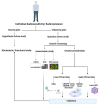Identification of Novel Regulators of Radiosensitivity Using High-Throughput Genetic Screening
- PMID: 35955908
- PMCID: PMC9369104
- DOI: 10.3390/ijms23158774
Identification of Novel Regulators of Radiosensitivity Using High-Throughput Genetic Screening
Abstract
The biological impact of ionizing radiation (IR) on humans depends not only on the physical properties and absorbed dose of radiation but also on the unique susceptibility of the exposed individual. A critical target of IR is DNA, and the DNA damage response is a safeguard mechanism for maintaining genomic integrity in response to the induced cellular stress. Unrepaired DNA lesions lead to various mutations, contributing to adverse health effects. Cellular sensitivity to IR is highly correlated with the ability of cells to repair DNA lesions, in particular coding sequences of genes that affect that process and of others that contribute to preserving genomic integrity. However, accurate profiling of the molecular events underlying individual sensitivity requires techniques with sensitive readouts. Here we summarize recent studies that have used whole-genome analysis and identified genes that impact individual radiosensitivity. Whereas microarray and RNA-seq provide a snapshot of the transcriptome, RNA interference (RNAi) and CRISPR-Cas9 techniques are powerful tools that enable modulation of gene expression and characterizing the function of specific genes involved in radiosensitivity or radioresistance. Notably, CRISPR-Cas9 has altered the landscape of genome-editing technology with its increased readiness, precision, and sensitivity. Identifying critical regulators of cellular radiosensitivity would help tailor regimens that enhance the efficacy of therapeutic treatments and fast-track prediction of clinical outcomes. It would also contribute to occupational protection based on average individual sensitivity, as well as the formulation of countermeasures to the harmful effects of radiation.
Keywords: CRISPR-Cas9; genome editing; ionizing radiation; radioresistance; radiosensitivity.
Conflict of interest statement
The authors declare no conflict of interest.
Figures
Similar articles
-
Gene Therapy with CRISPR/Cas9 Coming to Age for HIV Cure.AIDS Rev. 2017 Oct-Dec;19(3):167-172. AIDS Rev. 2017. PMID: 29019352
-
Evaluation of ATM heterozygous mutations underlying individual differences in radiosensitivity using genome editing in human cultured cells.Sci Rep. 2017 Jul 20;7(1):5996. doi: 10.1038/s41598-017-06393-8. Sci Rep. 2017. PMID: 28729543 Free PMC article.
-
Exploration of genetic basis underlying individual differences in radiosensitivity within human populations using genome editing technology.J Radiat Res. 2018 Apr 1;59(suppl_2):ii75-ii82. doi: 10.1093/jrr/rry007. J Radiat Res. 2018. PMID: 29528422 Free PMC article. Review.
-
Genome-Wide CRISPR Screen for Unveiling Radiosensitive and Radioresistant Genes.J Vis Exp. 2025 May 23;(219). doi: 10.3791/67982. J Vis Exp. 2025. PMID: 40489409
-
CRISPR/Cas9-based epigenome editing: An overview of dCas9-based tools with special emphasis on off-target activity.Methods. 2019 Jul 15;164-165:109-119. doi: 10.1016/j.ymeth.2019.05.003. Epub 2019 May 6. Methods. 2019. PMID: 31071448 Review.
Cited by
-
FTO inhibition mitigates high-fat diet-induced metabolic disturbances and cognitive decline in SAMP8 mice.Mol Med. 2025 Feb 21;31(1):73. doi: 10.1186/s10020-025-01126-4. Mol Med. 2025. PMID: 39984825 Free PMC article.
-
FTO overexpression expedites wound healing and alleviates depression in burn rats through facilitating keratinocyte migration and angiogenesis via mediating TFPI-2 demethylation.Mol Cell Biochem. 2024 Feb;479(2):325-335. doi: 10.1007/s11010-023-04719-x. Epub 2023 Apr 19. Mol Cell Biochem. 2024. PMID: 37074506
-
CRISPR/Cas9 system: a novel approach to overcome chemotherapy and radiotherapy resistance in cancer.Naunyn Schmiedebergs Arch Pharmacol. 2025 Apr;398(4):3373-3408. doi: 10.1007/s00210-024-03480-2. Epub 2024 Nov 19. Naunyn Schmiedebergs Arch Pharmacol. 2025. PMID: 39560750 Review.
-
Predicting head and neck cancer response to radiotherapy with a chemokine-based model.Sci Rep. 2025 Aug 4;15(1):28450. doi: 10.1038/s41598-025-13346-z. Sci Rep. 2025. PMID: 40760079 Free PMC article.
-
Systematic Comparison of CRISPR and shRNA Screens to Identify Essential Genes Using a Graph-Based Unsupervised Learning Model.Cells. 2024 Oct 4;13(19):1653. doi: 10.3390/cells13191653. Cells. 2024. PMID: 39404416 Free PMC article.
References
-
- Ulyanenko S., Pustovalova M., Koryakin S., Beketov E., Lychagin A., Ulyanenko L., Kaprin A., Grekhova A., Ozerova A.M., Ozerov I.V., et al. Formation of γH2AX and pATM Foci in Human Mesenchymal Stem Cells Exposed to Low Dose-Rate Gamma-Radiation. Int. J. Mol. Sci. 2019;20:2645. doi: 10.3390/ijms20112645. - DOI - PMC - PubMed
-
- Pustovalova M., Astrelina T.A., Grekhova A., Vorobyeva N., Tsvetkova A., Blokhina T., Nikitina V., Suchkova Y., Usupzhanova D., Brunchukov V., et al. Residual γH2AX foci induced by low dose X-ray radiation in bone marrow mesenchymal stem cells do not cause accelerated senescence in the progeny of irradiated cells. Aging. 2017;9:2397–2410. doi: 10.18632/aging.101327. - DOI - PMC - PubMed
-
- Xue L., Yu N., Furusawa Y., Okayasu R., Tong J., Cao J., Fan S. Regulation of ATM in DNA double strand break repair accounts for the radiosensitivity in human cells exposed to high linear energy transfer ionizing radiation. Mutat. Res. Mol. Mech. Mutagen. 2009;670:15–23. doi: 10.1016/j.mrfmmm.2009.06.016. - DOI - PubMed
Publication types
MeSH terms
Substances
Grants and funding
LinkOut - more resources
Full Text Sources


